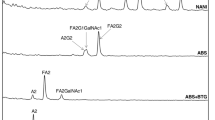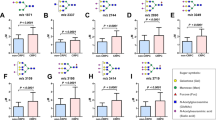Abstract
The factors that affect the progression of prostatic carcinoma are poorly understood, but it is known that carbohydrate antigens on the tumour cell surface play a role in the transforming and metastatic processes. The present report aimed to perform a comparative, lectin-histochemical study of benign and carcinomatous prostates, using a battery of 15 lectins, in combination with monoclonal antibodies against Lewis antigens, and a semi quantitative study, to investigate the changes in glycosylation patterns that occur in prostatic carcinoma. Blocks from 27 necropsy cases of prostatic carcinoma were sectioned and stained with H&E, 15 biotinylated lectins chosen to probe for a wide range of oligosaccharide sequences within several categories of glycoprotein glycans, using a lectin-biotin avidin–peroxidase method, and monoclonal antibodies against Lewisa, sialyl Lewisa and sialyl Lewisx antigens. The glycophenotype of prostatic carcinoma differed from that of the noncancerous prostate in revealing more intense staining with the following lectins (AAA, UEA-1, DBA, WFA, VVA, HPA, BSA-1B4, MPA, ECA, AHA and CTA), while the binding patterns of (GNA and NPA) were almost similar in both prostatic carcinoma and the noncancerous prostate. Lewis antigens are found to be expressed in prostatic carcinomas but not in the noncancerous prostate. The observations of this study suggest that the gylcophenotype of transformed prostatic cells was modified. It showed a moderate increase in, and changing patterns of, fucosylation and galactosylation, increased branching of side chains and sharp rise in 2 deoxy, 2 acetamido galactosylation and masking process by sialylation, especially by α2–3 and α2–6 linkages. O-glycans seems to play an important role in the glycosylation patterns found in prostate carcinoma cells.

Similar content being viewed by others
References
Abel PD, Keane P, Leathem A, Tebbutt S, Williams G (1989) Change in glycoconjugate for the binding site of the lectin Ulex europeus 1 following malignant transformation of prostatic epithelium. Br J Urol 63:183–185
Arenas MI, Romo E, de Gaspar I, de Bethencourt FR, Sánchez-Chapado M, Fraile B, Paniagua R (1999) A lectin histochemistry comparative study in human normal prostate, benign prostatic hyperplasia, and prostatic carcinoma. Glycoconj J 16:375–382
Aubert M, Panicot L, Crotte C, Gibier P, Lombardo D, Sadoulet MO, Mas E (2000) Restoration of alpha (1, 2) fucosyltransferase activity decreases adhesive and metastatic properties of human pancreatic cancer cells. Cancer Res 60:1449–1456
Downs F, Herp A, Moschera J, Pigman W (1973) Beta-elimination and reduction reactions and some applications of dimethylsulfoxide on submaxillary glycoproteins. Biochim Biophys Acta 328:182–192
Drachenberg CB, Papadimitriou JC (1995) Aberrant pattern of lectin binding in low and high grade prostatic intraepithelial neoplasia. Cancer 75:2539–2544
Foster CS, McLoughlin J, Bashir I, Abel PD (1992) Markers of the metastatic phenotype in prostate cancer. Hum Pathol 23:381–394
Fukuda M (1996) Possible roles of tumour-associated carbohydrate antigens. Cancer Res 56:2237–2244
Hakomori S (1989) Aberrant glycosylation in tumours and tumour-associated carbohydrate antigens. Adv Cancer Res 52:257–331
Hakomori S (1992) Tumour-associated carbohydrate markers. In: Sell S (ed) Serological cancer markers. Humana, New Jersey, pp 207–232
Idikio HA (1997) Sialyl-Lewis-X, Gleason grade and stage in non-metastatic human prostate cancer. Glycoconj J 14:875–877
Idikio HA, Manickavel V (1991) Correlation of blood group antigen expression and oncogene-related proteins in malignant prostatic tissues. Pathol Res Pract 187:189–197
Ito N, Hirota T (1992) Histochemical and cytochemical localization of blood group antigens. Prog Histochem Cytochem 25:1–85
Janssen T, Petein M, Van Velthoven R, Van Leer P, Fourmarier M, Vanegas JP, Danguy A, Schulman C, Pasteels JL, Kiss R (1996) Differential histochemical peanut agglutinin stain in benign and malignant human prostate tumours: relationship with prostatic specific antigen immunostain and nuclear DNA content. Hum Pathol 27:1341–1347
Jones CJ, Stoddart RW (1986) A post-embedding avidin-biotin peroxidase system to demonstrate the light and electron microscopic localization of lectin binding sites in rat kidney tubules. Histochem J 18:371–379
Jorgensen T, Berner A, Kaalhus O, Tveter KJ, Danielsen HE, Bryne M (1995) Up-regulation of the oligosaccharide sialyl Lewisx: a new prognostic parameter in metastatic prostate cancer. Cancer Res 55:1817–1819
Jorgensen T, Kanagasingam Y, Kaalhus O, Tveter KJ, Bryne M, Skjørten F, Berner A, Danielsen HE (1997) Prognostic factors in patients with metastatic (stage D2) prostate cancer: experience from the Scandinavian Prostatic Cancer Group Study-2. J Urol 158:164–170
Loy TS, Kyle J, Bickel JT (1989) Binding of soybean agglutinin lectin to prostatic hyperplasia and adenocarcinoma. Cancer 63:1583–1586
Martensson S, Bigler SA, Brown M, Lange PH, Brawer MK, Hakomori S (1995) Sialyl-Lewis(x) and related carbohydrate antigens in the prostate. Hum Pathol 26:735–739
McMahon RF, McWilliam LJ, Clarke NW, George NJ (1994) Altered saccharide sequences in two groups of patients with metastatic prostatic carcinoma. Br J Urol 74:80–85
McNeal JE, Alroy J, Villers A, Redwine EA, Freiha FS, Stamey TA (1991) Mucinous differentiation in prostatic adenocarcinoma. Hum Pathol 22:979–988
Ogawa J, Sano A, Inoue H, Koide S (1995) Expression of Lewis-related antigen and prognosis in stage I non-small cell lung cancer. Ann Thorac Surg 59:412–415
Perlman EJ, Epstein JI (1990) Blood group antigen expression in dysplasia and adenocarcinoma of the prostate. Am J Surg Pathol 14:810–818
Söderstrom KO (1987) Lectin binding to prostatic adenocarcinoma. Cancer 60:1823–1831
Young WW Jr, Mills SE, Lippert MC, Ahmed P, Lau SK (1988) Deletion of antigens of the Lewis a/b blood group family in human prostatic carcinoma. Am J Pathol 131:578–586
Zhang S, Zhang HS, Cordon-Cardo C, Reuter VE, Singhal AK, Lloyd KO, Livingston PO (1997) Selection of tumour antigens as targets for immune attack using Immunohistochemistry: II. Blood group-related antigens. Int J Cancer 73:50–56
Acknowledgements
This work was funded by Overseas Research Students Awards Scheme and the University of Manchester
Author information
Authors and Affiliations
Corresponding author
Rights and permissions
About this article
Cite this article
Khabaz, M.N., McClure, J., McClure, S. et al. Glycophenotype of prostatic carcinomas. Comp Clin Pathol 20, 5–14 (2011). https://doi.org/10.1007/s00580-009-0954-0
Received:
Accepted:
Published:
Issue Date:
DOI: https://doi.org/10.1007/s00580-009-0954-0




